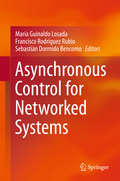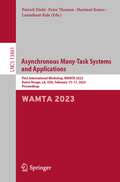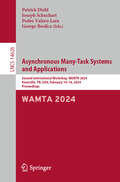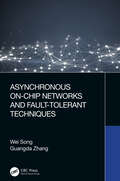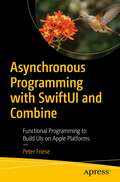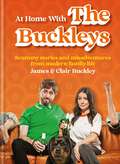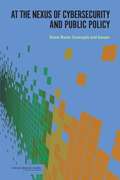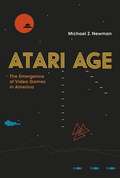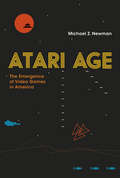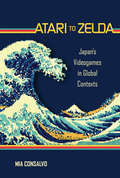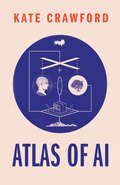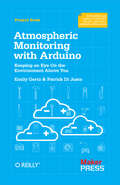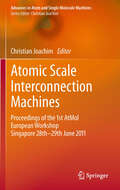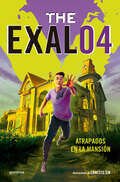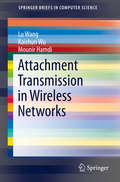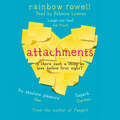- Table View
- List View
Asynchronous Control for Networked Systems
by María Guinaldo Losada Francisco Rodríguez Rubio Sebastián Dormido BencomoThis book sheds light on networked control systems; it describes different techniques for asynchronous control, moving away from the periodic actions of classical control, replacing them with state-based decisions and reducing the frequency with which communication between subsystems is required. The text focuses specially on event-based control. Split into two parts, Asynchronous Control for Networked Systems begins by addressing the problems of single-loop networked control systems, laying out various solutions which include two alternative model-based control schemes (anticipatory and predictive) and the use of H2/H∞ robust control to deal with network delays and packet losses. Results on self-triggering and send-on-delta sampling are presented to reduce the need for feedback in the loop. In Part II, the authors present solutions for distributed estimation and control. They deal first with reliable networks and then extend their results to scenarios in which delays and packet losses may occur. The novel results presented in Asynchronous Control for Networked Systems are transmitted in a concise and clear style supported by simulation and experimental examples. Some applications are also provided. Academic researchers and graduate students investigating control theory, control engineering and computer communications systems can use this monograph to learn how asynchronous control helps tackle the problems of networked systems in centralized and distributed schemes. Control practitioners at work in power systems, vehicle coordination and traffic networks will also find this book helpful in improving the performance of their systems.
Asynchronous Many-Task Systems and Applications: First International Workshop, WAMTA 2023, Baton Rouge, LA, USA, February 15–17, 2023, Proceedings (Lecture Notes in Computer Science #13861)
by Patrick Diehl Peter Thoman Hartmut Kaiser Laxmikant KaleThis book constitutes the proceedings of the Workshop on Asynchronous Many-Task Systems and Applications 2023 in Baton Rouge, LA, USA, February 2023. The workshop present the advantages and challenges of task-based programming on modern and future HPC systems.The 6 full papers included in this volume were carefully reviewed and selected from 7 submissions.
Asynchronous Many-Task Systems and Applications: Second International Workshop, WAMTA 2024, Knoxville, TN, USA, February 14–16, 2024, Proceedings (Lecture Notes in Computer Science #14626)
by Pedro Valero-Lara Patrick Diehl George Bosilca Joseph SchuchartThis book constitutes the refereed proceedings of the Second International Workshop on Asynchronous Many-Task Systems and Applications, WAMTA 2024, held in Knoxville, TN, USA during February 14–16, 2024. The 11 full papers and 5 short papers included in this book were carefully reviewed and selected from 20 submissions. The WAMTA 2024 proceedings help developers, users, and proponents of these models and systems share experience, discuss how they meet the challenges posed by Exascale system architectures, and explore opportunities for increased performance, robustness, productivity, and full-system utilization.
Asynchronous On-Chip Networks and Fault-Tolerant Techniques
by Wei Song Guangda ZhangAsynchronous On-Chip Networks and Fault-Tolerant Techniques is the first comprehensive study of fault-tolerance and fault-caused deadlock effects in asynchronous on-chip networks, aiming to overcome these drawbacks and ensure greater reliability of applications. As a promising alternative to the widely used synchronous on-chip networks for multicore processors, asynchronous on-chip networks can be vulnerable to faults even if they can deliver the same performance with much lower energy and area compared with their synchronous counterparts – faults can not only corrupt data transmission but also cause a unique type of deadlock. By adopting a new redundant code along with a dynamic fault detection and recovery scheme, the authors demonstrate that asynchronous on-chip networks can be efficiently hardened to tolerate both transient and permanent faults and overcome fault-caused deadlocks. This book will serve as an essential guide for researchers and students studying interconnection networks, fault-tolerant computing, asynchronous system design, circuit design and on-chip networking, as well as for professionals interested in designing fault-tolerant and high-throughput asynchronous circuits.
Asynchronous Programming with SwiftUI and Combine: Functional Programming to Build UIs on Apple Platforms
by Peter FrieseDevelop UI-heavy applications more easily, faster, and error-free. Based on several enhancements to the Swift language, SwiftUI takes a declarative approach to building UIs. Instead of imperatively coding the UI, this book will show you how to describe how you want your UI to look. SwiftUI treats the UI as a function of its state, thereby making managing your app’s state a lot easier. Change the underlying data model to redraw all parts of the UI that are connected to that particular slice of data. Likewise, easily update the underlying data model from the UI elements your data model is connected to. Combine is Apple’s Functional Reactive Programming framework. It complements SwiftUI and other frameworks, such as the networking APIs, in a natural way. Using Combine, you can subscribe to events and describe data processing in a way that is free of side effects. This allows for an easier implementation of event-driven applications. Using SwiftUI and Combine build more error-free apps in a shorter amount of time, targeting all of Apple’s platforms (iOS, iPadOS, watchOS, macOS, tvOS) with little to no overhead. By the end of the book you will have a solid understanding for architecting and implementing UI-heavy apps in a declarative and functional reactive way using SwiftUI, Combine, and async/await. You will: - Build simple and gradually more complex UIs in SwiftUI - Understand SwiftUI’s state management system - Work with Combine and Swift’s new async/await APIs to access the network and access other asynchronous APIs - Architect and structure modern applications on Apple platforms using SwiftUI, Combine, and async/await
At Home With The Buckleys: Scummy stories and misadventures from modern family life
by James & BuckleyCLAIR: We've been let loose on a book... whose bright idea was that?JAMES: We haven't got anything to say!CLAIR: Don't tell them that before they buy it...JAMES: They'll work it out eventually!CLAIR: Well, we've managed to put together some bits and pieces that might be interesting - or at least funny/weird/silly.JAMES: Probably not.CLAIR: No... probably not. Though if you like the vlogs, you might like it?JAMES: No one likes the vlogs.CLAIR: True.JAMES: Anyway, enjoy!At Home with The Buckleys is one couple's take on the wild ride that is modern marriage, parenting and adulting. Told from both sides, Clair and James share a collection of hilarious stories and comedy excursions from their early lives, years of cult TV fame, having children and setting up their YouTube channel.
At Home With The Buckleys: Scummy stories and misadventures from modern family life
by James & BuckleyCLAIR: We've been let loose on a book... whose bright idea was that?JAMES: We haven't got anything to say!CLAIR: Don't tell them that before they buy it...JAMES: They'll work it out eventually!CLAIR: Well, we've managed to put together some bits and pieces that might be interesting - or at least funny/weird/silly.JAMES: Probably not.CLAIR: No... probably not. Though if you like the vlogs, you might like it?JAMES: No one likes the vlogs.CLAIR: True.JAMES: Anyway, enjoy!At Home with The Buckleys is one couple's take on the wild ride that is modern marriage, parenting and adulting. Told from both sides, Clair and James share a collection of hilarious stories and comedy excursions from their early lives, years of cult TV fame, having children and setting up their YouTube channel.(p) 2023 Octopus Publishing Group
At Home With The Buckleys: Scummy stories and misadventures from modern family life
by James & BuckleyCLAIR: We've been let loose on a book... whose bright idea was that?JAMES: We haven't got anything to say!CLAIR: Don't tell them that before they buy it...JAMES: They'll work it out eventually!CLAIR: Well, we've managed to put together some bits and pieces that might be interesting - or at least funny/weird/silly.JAMES: Probably not.CLAIR: No... probably not. Though if you like the vlogs, you might like it?JAMES: No one likes the vlogs.CLAIR: True.JAMES: Anyway, enjoy!At Home with The Buckleys is one couple's take on the wild ride that is modern marriage, parenting and adulting. Told from both sides, Clair and James share a collection of hilarious stories and comedy excursions from their early lives, years of cult TV fame, having children and setting up their YouTube channel.
At Large
by Charles C. Mann David H. FreedmanHailed as "a chilling portrait" by The Boston Globe and "a crafty thriller" by Newsweek, this astonishing story of an obsessive hacker promises to change the way you look at the Internet forever. At Large chronicles the massive manhunt that united hard-nosed FBI agents, computer nerds, and uptight security bureaucrats against an elusive computer outlaw who broke into highly secured computer systems at banks, universities, federal agencies, and top-secret military weapons-research sites. Here is "a real-life tale of cops vs. hackers, by two technology writers with a flair for turning a complicated crime and investigation into a fast-moving edge-of-your-seat story" (Kirkus Reviews, starred). At Large blows the lid off the frightening vulnerability of the global online network, which leaves not only systems, but also individuals, exposed.
At War with PTSD: Battling Post Traumatic Stress Disorder with Virtual Reality
by Robert N. McLayThe Spartans called it The Trembler; recent history has seen it termed shell shock, combat fatigue, soldier’s heart, and Vietnam Syndrome. Whatever the name, post traumatic stress disorder (PTSD) has always been with us. With 20 percent of the Veterans of the wars in Afghanistan and Iraq exhibiting PTSD symptoms, the United States military has a strong interest in combating the condition. Navy psychiatrist Robert N. McLay has been at the forefront of these efforts. This is his story of using virtual reality to treat Service Members and Veterans with PTSD.As a practicing psychiatrist who works with Veterans and civilians coping with PTSD, McLay had known for years before the September 11, 2001, attacks that effective treatments for the condition were elusive. When active duty called, he met the challenge, becoming the primary investigator on PTSD treatment projects that had Service Members face the ghosts of war in a computer simulator. After using this new form of exposure therapy on the home front, McLay and his team believed they had found a promising way to work with warriors broken by combat, so in 2008 they took it to the front line in Fallujah, Iraq, with the First Marine Expeditionary Force. Several years into the project, McLay recounts openly and with bleak honesty the successes, failures, and limits of virtual reality treatment for PTSD. Filled with poignant firsthand accounts of war and its psychological aftermath, At War with PTSD explains the difficulties of using this specialized technology in the field and discusses such challenges as helping people who refuse to believe in PTSD, including those diagnosed with it. So far, the virtual reality program shows more promise than traditional therapies. And although McLay remains unsure why or how, his experiences hold out hope for those suffering from this devastating disorder.
At the Intersection of Language, Logic, and Information: ESSLLI 2018 Student Session, Sofia, Bulgaria, August 6–17, 2018, Selected Papers (Lecture Notes in Computer Science #11667)
by Eric Pacuit Jennifer SikosThe European Summer School in Logic, Language and Information (ESSLLI) is organized every year by the Association for Logic, Language and Information (FoLLI) in different sites around Europe. The papers cover vastly dierent topics, but each fall in the intersection of the three primary topics of ESSLLI: Logic, Language and Computation. The 14 papers presented in this volume have been selected among 24 papers presented by talks or posters at the Student Sessions of the 30th edition of ESSLLI, held in 2018 in Sofia, Bulgaria.The Student Session is a forum for PhD and Master students to present their research at the interfaces of logic, language and computation. It features three tracks: Logic and Computation (LoCo), Logic and Language (LoLa), and Language and Computation (LaCo).
At the Nexus of Cybersecurity and Public Policy: Some Basic Concepts and Issues
by David ClarkWe depend on information and information technology (IT) to make many of our day-to-day tasks easier and more convenient. Computers play key roles in transportation, health care, banking, and energy. Businesses use IT for payroll and accounting, inventory and sales, and research and development. Modern military forces use weapons that are increasingly coordinated through computer-based networks. Cybersecurity is vital to protecting all of these functions. Cyberspace is vulnerable to a broad spectrum of hackers, criminals, terrorists, and state actors. Working in cyberspace, these malevolent actors can steal money, intellectual property, or classified information; impersonate law-abiding parties for their own purposes; damage important data; or deny the availability of normally accessible services. Cybersecurity issues arise because of three factors taken together - the presence of malevolent actors in cyberspace, societal reliance on IT for many important functions, and the presence of vulnerabilities in IT systems. What steps can policy makers take to protect our government, businesses, and the public from those would take advantage of system vulnerabilities? "At the Nexus of Cybersecurity and Public Policy" offers a wealth of information on practical measures, technical and nontechnical challenges, and potential policy responses. According to this report, cybersecurity is a never-ending battle; threats will evolve as adversaries adopt new tools and techniques to compromise security. Cybersecurity is therefore an ongoing process that needs to evolve as new threats are identified. "At the Nexus of Cybersecurity and Public Policy" is a call for action to make cybersecurity a public safety priority. For a number of years, the cybersecurity issue has received increasing public attention; however, most policy focus has been on the short-term costs of improving systems. In its explanation of the fundamentals of cybersecurity and the discussion of potential policy responses, this book will be a resource for policy makers, cybersecurity and IT professionals, and anyone who wants to understand threats to cyberspace.
Atari Age: The Emergence of Video Games in America
by Michael Z. NewmanBeginning with the release of the Magnavox Odyssey and Pong in 1972, video games, whether played in arcades and taverns or in family rec rooms, became part of popular culture, like television. In fact, video games were sometimes seen as an improvement on television because they spurred participation rather than passivity. These "space-age pinball machines" gave coin-operated games a high-tech and more respectable profile. In Atari Age, Michael Newman charts the emergence of video games in America from ball-and-paddle games to hits like Space Invaders and Pac-Man, describing their relationship to other amusements and technologies and showing how they came to be identified with the middle class, youth, and masculinity.Newman shows that the "new media" of video games were understood in varied, even contradictory ways. They were family fun (but mainly for boys), better than television (but possibly harmful), and educational (but a waste of computer time). Drawing on a range of sources -- including the games and their packaging; coverage in the popular, trade, and fan press; social science research of the time; advertising and store catalogs; and representations in movies and television -- Newman describes the series of cultural contradictions through which the identity of the emerging medium worked itself out. Would video games embody middle-class respectability or suffer from the arcade's unsavory reputation? Would they foster family togetherness or allow boys to escape from domesticity? Would they make the new home computer a tool for education or just a glorified toy? Then, as now, many worried about the impact of video games on players, while others celebrated video games for familiarizing kids with technology essential for the information age.
Atari Age: The Emergence of Video Games in America
by Michael Z. NewmanThe cultural contradictions of early video games: a medium for family fun (but mainly for middle-class boys), an improvement over pinball and television (but possibly harmful) Beginning with the release of the Magnavox Odyssey and Pong in 1972, video games, whether played in arcades and taverns or in family rec rooms, became part of popular culture, like television. In fact, video games were sometimes seen as an improvement on television because they spurred participation rather than passivity. These “space-age pinball machines” gave coin-operated games a high-tech and more respectable profile. In Atari Age, Michael Newman charts the emergence of video games in America from ball-and-paddle games to hits like Space Invaders and Pac-Man, describing their relationship to other amusements and technologies and showing how they came to be identified with the middle class, youth, and masculinity.Newman shows that the “new media” of video games were understood in varied, even contradictory ways. They were family fun (but mainly for boys), better than television (but possibly harmful), and educational (but a waste of computer time). Drawing on a range of sources—including the games and their packaging; coverage in the popular, trade, and fan press; social science research of the time; advertising and store catalogs; and representations in movies and television—Newman describes the series of cultural contradictions through which the identity of the emerging medium worked itself out. Would video games embody middle-class respectability or suffer from the arcade's unsavory reputation? Would they foster family togetherness or allow boys to escape from domesticity? Would they make the new home computer a tool for education or just a glorified toy? Then, as now, many worried about the impact of video games on players, while others celebrated video games for familiarizing kids with technology essential for the information age.
Atari to Zelda: Japan's Videogames in Global Contexts
by Mia ConsalvoIn the early days of arcades and Nintendo, many players didn't recognize Japanese games as coming from Japan; they were simply new and interesting games to play. But since then, fans, media, and the games industry have thought further about the "Japaneseness" of particular games. Game developers try to decide whether a game's Japaneseness is a selling point or stumbling block; critics try to determine what elements in a game express its Japaneseness -- cultural motifs or technical markers. Games were "localized," subjected to sociocultural and technical tinkering. In this book, Mia Consalvo looks at what happens when Japanese games travel outside Japan, and how they are played, thought about, and transformed by individuals, companies, and groups in the West. Consalvo begins with players, first exploring North American players' interest in Japanese games (and Japanese culture in general) and then investigating players' DIY localization of games, in the form of ROM hacking and fan translating. She analyzes several Japanese games released in North America and looks in detail at the Japanese game company Square Enix. She examines indie and corporate localization work, and the rise of the professional culture broker. Finally, she compares different approaches to Japaneseness in games sold in the West and considers how Japanese games have influenced Western games developers. Her account reveals surprising cross-cultural interactions between Japanese games and Western game developers and players, between Japaneseness and the market.
Atari to Zelda: Japan's Videogames in Global Contexts
by Mia ConsalvoThe cross-cultural interactions of Japanese videogames and the West, from DIY localization by fans to corporate strategies of “Japaneseness.”In the early days of arcades and Nintendo, many players didn't recognize Japanese games as coming from Japan; they were simply new and interesting games to play. But since then, fans, media, and the games industry have thought further about the “Japaneseness” of particular games. Game developers try to decide whether a game's Japaneseness is a selling point or stumbling block; critics try to determine what elements in a game express its Japaneseness—cultural motifs or technical markers. Games were “localized,” subjected to sociocultural and technical tinkering. In this book, Mia Consalvo looks at what happens when Japanese games travel outside Japan, and how they are played, thought about, and transformed by individuals, companies, and groups in the West. Consalvo begins with players, first exploring North American players' interest in Japanese games (and Japanese culture in general) and then investigating players' DIY localization of games, in the form of ROM hacking and fan translating. She analyzes several Japanese games released in North America and looks in detail at the Japanese game company Square Enix. She examines indie and corporate localization work, and the rise of the professional culture broker. Finally, she compares different approaches to Japaneseness in games sold in the West and considers how Japanese games have influenced Western games developers. Her account reveals surprising cross-cultural interactions between Japanese games and Western game developers and players, between Japaneseness and the market.
Atlas of AI: Power, Politics, and the Planetary Costs of Artificial Intelligence
by Kate CrawfordThe hidden costs of artificial intelligence, from natural resources and labor to privacy, equality, and freedom&“Eloquent, clear and profound—this volume is a classic for our times. It draws our attention away from the bright shiny objects of the new colonialism through elucidating the social, material and political dimensions of Artificial Intelligence.&”—Geoffrey C. Bowker, University of California, Irvine What happens when artificial intelligence saturates political life and depletes the planet? How is AI shaping our understanding of ourselves and our societies? In this book Kate Crawford reveals how this planetary network is fueling a shift toward undemocratic governance and increased racial, gender, and economic inequality. Drawing on more than a decade of research, award‑winning science, and technology, Crawford reveals how AI is a technology of extraction: from the energy and minerals needed to build and sustain its infrastructure, to the exploited workers behind &“automated&” services, to the data AI collects from us. Rather than taking a narrow focus on code and algorithms, Crawford offers us a political and a material perspective on what it takes to make artificial intelligence and where it goes wrong. While technical systems present a veneer of objectivity, they are always systems of power. This is an urgent account of what is at stake as technology companies use artificial intelligence to reshape the world.
Atlas of the Food System: Challenges for a Sustainable Transition of the Lisbon Region
by Teresa Marat-Mendes Sara Silva Lopes João Cunha Borges Patrícia Bento d'AlmeidaThis book is a visual guide to the territorial dynamics operating within a territory. The reading of such dynamics is fundamental in understanding the role of food in cities. This atlas provides a refreshing approach to the study of the city and of its territory, expanded from the perspective of the food system. This book illustrates the impacts of urban planning options on the function of the contemporary Food System of the Lisbon Region, while disclosing its associated urban form solutions. It provides a possible methodology for the reading of the food system based on an analysis of planning instruments and their morphological outcomes, both in the territory but also on the various built forms which have resulted over time. A key focus of the atlas is exploring how planning has regulated the evolution of the Lisbon Region since the 20th century and its implications on the food system. The atlas results from an exhaustive survey and research work conducted in Lisbon Metropolitan Area for a research project, SPLACH – Spatial Planning for Change, for the past 3 years, in terms of the analysis of its Food System and Urban Planning, aiming to inform the delineation of planning strategies towards a sustainable urban environment. It is an important reference for planners, architects, planning and architecture students as well as municipal technicians and the general public, as it provides a refreshing and useful source of information to support further readings about the food system and its relations to urban planning instruments and urban form solutions. Furthermore, it builds a contemporary reading about possible solutions to promote a sustainable transition of the current food systems, while enhancing the strategic role of planning and urban form.
Atlassian Confluence 5 Essentials
by Stefan KohlerAtlassian Confluence 5 Essentials is written in a friendly, tutorial style packed full of practical information to help get you started with Confluence and collaborating on projects more efficiently.If you just started with Confluence, as a user or administrator, this book will give you a running start and teach you everything you need to know. This book will also appeal to veteran users as it will give you new insights and tricks for how to use Confluence even more efficiently. All you need to get started with this book is some basic knowledge on how to use an Internet browser. As an administrator, you will need some basic knowledge about your organization's standard operating environment to install Confluence.
Atmospheric Monitoring with Arduino: Building Simple Devices to Collect Data About the Environment
by Emily Gertz Patrick Di JustoMakers around the globe are building low-cost devices to monitor the environment, and with this hands-on guide, so can you. Through succinct tutorials, illustrations, and clear step-by-step instructions, you’ll learn how to create gadgets for examining the quality of our atmosphere, using Arduino and several inexpensive sensors.Detect harmful gases, dust particles such as smoke and smog, and upper atmospheric haze—substances and conditions that are often invisible to your senses. You’ll also discover how to use the scientific method to help you learn even more from your atmospheric tests.Get up to speed on Arduino with a quick electronics primerBuild a tropospheric gas sensor to detect carbon monoxide, LPG, butane, methane, benzene, and many other gasesCreate an LED Photometer to measure how much of the sun’s blue, green, and red light waves are penetrating the atmosphereBuild an LED sensitivity detector—and discover which light wavelengths each LED in your Photometer is receptive toLearn how measuring light wavelengths lets you determine the amount of water vapor, ozone, and other substances in the atmosphereUpload your data to Cosm and share it with others via the Internet"The future will rely on citizen scientists collecting and analyzing their own data. The easy and fun gadgets in this book show everyone from Arduino beginners to experienced Makers how best to do that."--Chris Anderson, Editor in Chief of Wired magazine, author of Makers: The New Industrial Revolution (Crown Business)
Atomic Scale Interconnection Machines: Proceedings of the 1st AtMol European Workshop Singapore 28th-29th June 2011 (Advances in Atom and Single Molecule Machines)
by Christian JoachimThis volume documents the first International Workshop on Atomic Scale Interconnection Machines organised by the European Integrated Project AtMol in June 2011 in Singapore. The four sessions, discussed here in revised contributions by high level speakers, span the subjects of multi-probe UHV instrumentation, atomic scale nano-material nanowires characterization, atomic scale surface conductance measurements, surface atomic scale mechanical machineries. This state-of-the-art account brings academic researchers and industry engineers access to the tools they need to be at the forefront of the atomic scale technology revolution.
Atrapados en la mansión
by TheExal04EXAL ESTÁ PREPARADO PARA CUALQUIER COSA. O ESO SE PENSABA... Cuando sus amigos deciden alquilar una mansión para celebrar su cumpleaños, Exal no lo duda: ¡va a ser un PLANAZO! Pero pronto se empieza a LIAR más de lo que esperaban: *Uno de sus amigos desaparece. *Hay ruidos extraños en la casa. *Y lo mejor (o peor) de todo: ¡han descubierto un pasadizo secreto! Nadie se imaginaba que lo que había comenzado como un simple juego se convertiría en un reto del que tendrían que salir con vida. ¿Hasta dónde estará Exal dispuesto a llegar? ¡Atrévete a descubrirlo!
Attachment Transmission in Wireless Networks (SpringerBriefs in Computer Science)
by Mounir Hamdi Lu Wang Kaishun WuThis brief presents the novel PHY layer technique, attachment transmission, which provides an extra control panel with minimum overhead. In addition to describing the basic mechanisms of this technique, this brief also illustrates the challenges, the theoretical model, implementation and numerous applications of attachment transmission. Extensive experiments demonstrate that attachment transmission is capable of exploiting and utilizing channel redundancy to deliver control information and thus it can provide significant support to numerous higher layer applications. The authors also address the critical problem of providing cost-effective coordination mechanisms for wireless design. The combination of new techniques and implementation advice makes this brief a valuable resource for researchers and professionals interested in wireless penetration and communication networks.
Attachment Ventilation Theory
by Angui LiThis open access book systematically summarizes the current research progress of attachment ventilation, covering vertical wall attachment, column attachment, and adaptive attachment ventilation. Attachment ventilation is a high-performance ventilation mode that was first proposed by the author, Prof. Angui Li 20 years ago. Now it has been widely used in office spaces, subway stations, high-speed railway stations, international airport terminals, and other large spaces. This book introduces attachment ventilation in detail to eliminate the cooling/heating load of the occupied zone and provide an expected environment for the air-conditioned zone. Attachment ventilation combines the advantages of traditional mixed ventilation and displacement ventilation. This book consists of six chapters, covering a series of airflow patterns, mechanisms, parameter correlations, and attachment ventilation design methods. It is helpful for HVAC engineers to design attachment ventilation effectively.
Attachments: Is there such a thing as love before first sight? The romantic comedy we all need to read in 2020
by Rainbow Rowell'Heartwarming, romantic and great fun' CLOSER Everyone in the newsroom knows that somebody is monitoring their emails, but Beth and Jennifer don't believe anyone would read their never-ending conversations. But Lincoln does, it's his job, and Beth and Jennifer's hilarious, no-holds-barred emails are the best part of his day. The only problem is he's starting to fall in love with Beth, and yet she doesn't even know he exists. With ex-boyfriends, office politics and family drama, there never seems to be a good time for Lincoln to introduce himself. But to get the life you want sometimes you need to put yourself out there...
